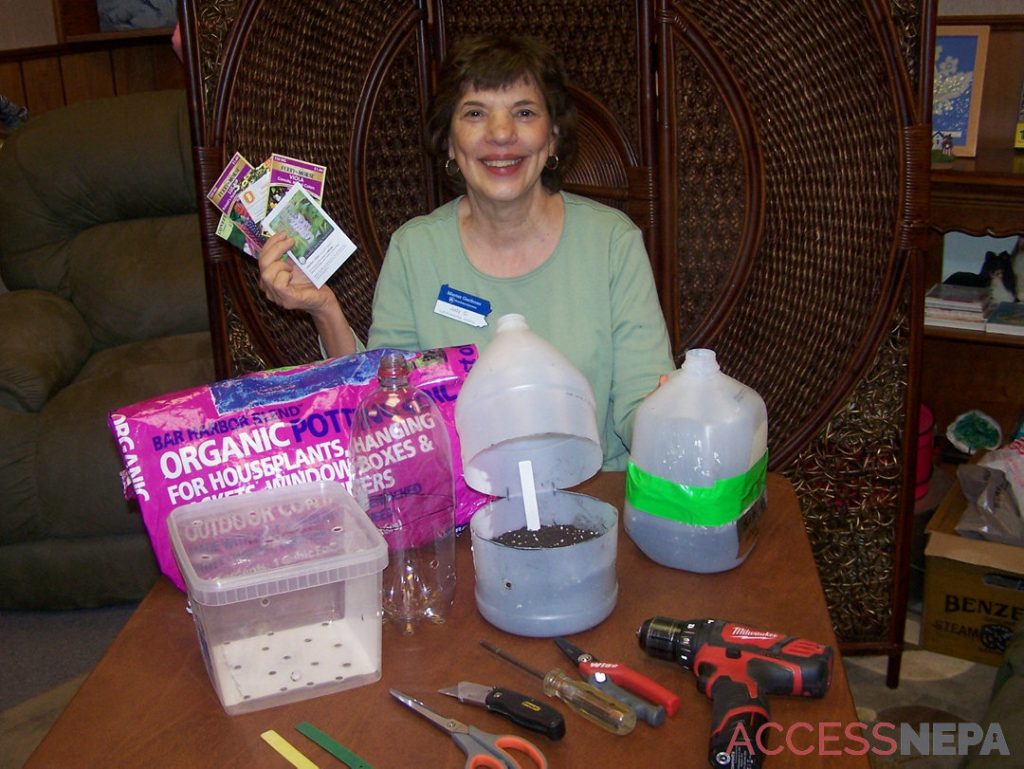BY JUDY COLEMAN
FOR THE VALLEY ADVANTAGE
If you suffer from gardening withdrawal and the seed catalogues are only making it worse, winter sowing may be just the remedy for those winter blues. Yes, fellow gardeners, you can start your summer gardens in the cold of winter!
Winter sowing is simply the process of starting your seeds in miniature greenhouses made from translucent containers. The containers are placed outdoors in the elements once freezing temperatures are here to stay in January or February. Mother Nature takes care of the rest.
This is how it is done:
- Start by collecting translucent containers such as milk, water or juice jugs, clear soda bottles, clam shell and other lidded storage containers. They need to be tall enough to add at least 3 inches of soil to the containers and have at least an additional 2 to 3 inches of head room above that to provide space for seedling growth.
- Put several drainage holes in the bottom of the container along with a few additional holes along the sides in case the bottom holes get clogged. If using a storage container with a lid also add some holes to the lid for ventilation.
- Cut the jugs or bottles around the middle, leaving an inch or so uncut to serve as a hinge. If using a jug with a handle, cut it so the hinge is just below the handle. This allows you to easily flip back the upper part of the jug to check on the seedlings when needed.
- Add at least 3 inches of all-purpose potting soil that is light, drains well, and contains some organic material like peat moss. Moisten the soil well and let it drain.
- Sow your seeds to the depth directed on seed package. Pat down the soil so the seeds make good contact and spray thoroughly. If you are sowing tiny seeds scatter and tamp them into the soil.
- Put a label inside the container.
- Seal the top half and bottom half of the jug together securely with a strip of duct tape or another heavy-duty tape along the cut seam. Do not put cap back on jug. The opening allows for air circulation and watering. If using a lidded container, secure the vented lid onto the container.
- Label and date outside of container. Paint pens work well.
- Move your mini greenhouse outside into the cold where it will get full sun, moisture from the snow and rain, and will be safe from wind and animals. You can put the greenhouse directly on the ground, on gravel, inside a larger container with drainage holes, on a table, or on your deck.
- Forget about it and let Mother Nature take over. When the weather starts to warm up you can begin checking for signs of germination. It is important to make sure your seedlings do not overheat and dry out. For ventilation and watering, flip back the top on nice days, moisten gently and close again at night. If weather gets cold again reseal the container. Once the seedlings start filling the container, it is time to open the lids.
- In the spring, when the seedlings have a few sets of true leaves and the soil in their permanent location is workable, it is time to transplant them. The seedlings go from jug to ground quite successfully.
Winter sowing is really easy: no grow lights, no hardening off, no fancy equipment and no fussing. It is also a rather frugal gardening technique. Your only expenses are the seeds and the potting mix!
What plants can you sow using this winter sowing technique? Look for seeds packets that say self-sowing, direct sow, cold hardy, or requiring cold stratification.
After several years of trial and error, I have had wonderful success sowing native plants and perennials in January. For just the cost of a packet of seeds, I have been able to add to my pollinator garden beautiful lupines (Lupinus), butterfly weed (Asclepias tuberosa), coneflowers (Echinacea purpurea), asters (Asteraceae), Shasta daisies (Leucanthemum x superbum), blanket flower (Gaillardia), anise hyssop (Agastache foeniculum) and blazing star (Liatris spicata). Perennials are the perfect plants to winter sow because most require what is called “cold stratification,” meaning they will germinate only after the seeds go through a period of freezing and thawing.Cool weather crops that can be winter sown include lettuce, kale, Swiss chard and plants in the brassica family, including broccoli, cabbage, cauliflower and cabbage. Herbs such as parsley, oregano and sage do well when winter sown. I sow these vegetables and herbs in February.
I have also successfully winter sown a few hardy annuals such as pansies, violas and marigolds in March.Winter sowing is a bit of an adventure and an experiment. If you are curious whether a particular flower can be successfully winter sown, go ahead and try it! This winter I will be trying, for the first-time, yarrow (Achillea millefolium), baptisia (Baptisia australis) and obedient plant (Physostegia virginiana), as well as sweet alyssum (Lobularia maritima).
Winter sowing is one of the easiest ways to get a garden full of color. In the spring, when you see the winter sown seedlings thriving in their miniature greenhouse, you will be hooked.
Judy Coleman is a Penn State Extension Master Gardener in Lackawanna County. Penn State Extension is dedicated to delivering science-based information to people, businesses and communities. They partner with and are funded by federal, state and county governments. For more information on what they’re doing in Lackawanna County, visit extension.psu.edu/lackawanna-county.




